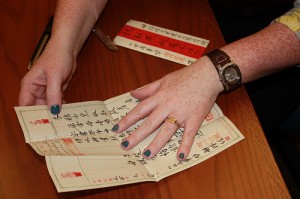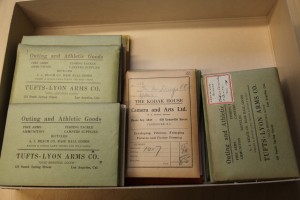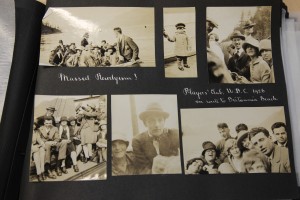May 25th, 2011 by sromkey | No Comments »
We recently had our friends from Chinese Canadian Stories (CCS) join us to host high school students from Sir Winston Churchill Secondary School for a tour of the Chung Collection and a Mandarin language lesson. Afterward, the researchers from CCS mentioned they had found an unopened letter in the Wah Shun Company fonds– could we open it and read what was inside?
Usually when we are first processing a new archival collection we will open unopened envelopes unless there is a compelling reason not to do so (for example a privacy concern, in which case the envelope would not be made available to researchers anyway). The thinking behind this practice is that it would be better for the letter to be gently opened by an archivist than to be torn open by a well-meaning but potentially destructive patron.
Since we had cameras on hand to document the collection tour, the CCS researchers also took photos of the letter opening. We opened it by carefully cutting a very thin slice off the top of the envelope with a pair of scissors. The letter is in Chinese but thankfully Joanne and Lilly from CCS were able to read it for us- the letter was written from a Chinese man in Vancouver, to his son in China, explaining that he was going to be sending him some goods and supplies, and also giving him advice on studying hard in school. No one may ever know why the letter wasn’t sent!

Opening the letter from the Wah Shun Company fonds
The letter can be found in Box 1 folder 3 of the Wah Shun Company fonds.
The photo is courtesy of the Chinese Canadian Stories project.
Posted in Collections, Research and learning | No Comments »
May 4th, 2011 by sromkey | No Comments »
Always wanted to “go down in the history books” but not sure how? It’s easy- answer the 2011 Canadian census, and answer YES to question 10. The census is a rich source of information for future researchers to understand ordinary Canadians. But they will only be able to see your data if you answer YES to question 10, which allows your data to be made available in 92 years, in the year 2103.

Graphic courtesy of the Association of Canadian Archivists.
The Association of Canadian Archivists is advocating for all Canadians to be aware of the implications behind question 10. Unfortunately, in the 2006 census only 56% of respondents agreed to allow their responses to be released in the year 2098. What can you do to stop this from happening again?
- Fill in the census form (information available on the Stats Can website if you have not received a form at your home: http://census2011.gc.ca/) and answer YES to question 10.
- Encourage your family and friends to do the same.
- Sign up for the Association of Canadian Archivists Facebook event to show your support.
- Print this poster from the ACA and hang it in your workplace.
To discover the rich information held in census data, go the the Library and Archives Canada Census page. The most recent census data available is from 1911.
Posted in Research and learning | No Comments »
March 7th, 2011 by sromkey | No Comments »
A while back I posted an iPhone app which some researchers use to keep track of photographs they take of documents they’ve consulted in archives. Miriam Posner, a colleague from Emory University libraries (who I met at the Digital Humanities Summer Institute a couple of summers back) has posted to her blog steps for taking your photos, converting them into searchable PDF documents, and saving them for future use in Zotero. You can read her full tutorial here. It’s specific to Macs.
Here’s a photo from the tutorial:
 Note how Miriam includes the full citation of the item she is using on a piece of note paper (NOT a post-it note though!) in every photograph she takes. This is a great idea. Another suggestion when using archival material is to start by taking a photo of the box label, and then the file number, before photographing any documents from inside the box so that you can re-trace your steps.
Note how Miriam includes the full citation of the item she is using on a piece of note paper (NOT a post-it note though!) in every photograph she takes. This is a great idea. Another suggestion when using archival material is to start by taking a photo of the box label, and then the file number, before photographing any documents from inside the box so that you can re-trace your steps.
You will also find this tutorial linked from our Archival Material research guide. Thanks Miriam!
Posted in Research and learning | No Comments »
February 16th, 2011 by sromkey | No Comments »
In January we were visited twice by students in ARST 550: Management of audio-visual and non-textual archives from the School of Library, Archival and Information Studies. This class focuses on the management of a variety of types of material, but they came to Rare Books and Special Collections particularly to work with photographic archives.
RBSC collects photographs in a variety of manners: they are often included in fonds or collections with other types of material, or we occasionally acquire them as single items. As for any type of material, the focus of our photographic archives is mainly British Columbia, but it also spills over into neighbouring provinces or states when the photographs are in the context of a mainly-B.C. collection. We collect photographs in all mediums, from lantern slides to negatives to prints.
The task at hand for the students in ARST550 was to appraise and in some cases accession photographs from our backlog. In all cases, we had very little provenance information or contextualizing data for the students to work with. In short, the photographs were a mystery. They did an excellent job of inspecting the photographs for their physical condition and content, and made recommendations about whether they should be added to our photograph collections.
A couple of interesting discoveries:
- We located a complete set of negatives from the prints in the B.W.W. MacDougall fonds. Furthermore, we located metadata in the form of index cards which is a match for the negatives. Check out the cool vintage negative envelopes and canisters:

B.W.W. McDougall negatives

B.W.W. McDougall negatives
- We found a really charming photograph album originating from a family called the Kidds. They appear to have been involved with the UBC Players club, and there are also photographs depicting Crescent Beach, mountaineering, and businesses such as Overwaitea Food. The album dates from 1924 to 1926. The photos shown below show a Players Club trip to Britannia Beach.

Kidd family album
Our thanks to the students for their excellent work, and to Prof. Jessica Bushey for coordinating the visits!
For more information on searching our photograph collections, please consult our Historical Photographs research guide.
Posted in Research and learning | No Comments »
December 11th, 2010 by sromkey | No Comments »
A post to the Society of American Archivists listserv mentioned this piece of software: ILINX Capture Mobile “allows you to capture an image of anything, attach keywords to it, so you and easily find it later, and then emails a PDF of the image back to you.” Seems like a tool with potential for those who wish to take pictures of rare or archival material in Rare Books and Special Collections or University Archives and keep track of citations, box locations, etc. While using a cell phone or digital camera to capture images of material in our reading room is allowed in RBSC and UA (within the constraints of copyright law and fair dealing) we always caution researchers to take careful note of what they are photographing so that they can cite it properly later.
Do you have an app, a tool or other method of keeping track of what you’ve seen in the reading room? Tell us about it in the comments and share with others!
Posted in Research and learning | No Comments »






